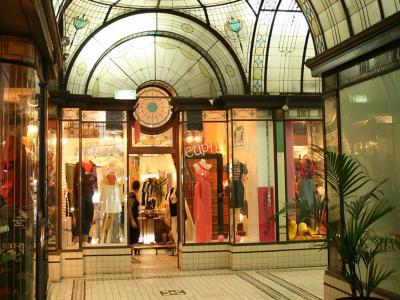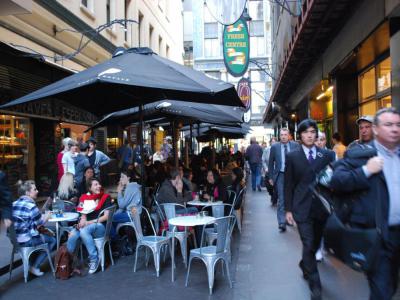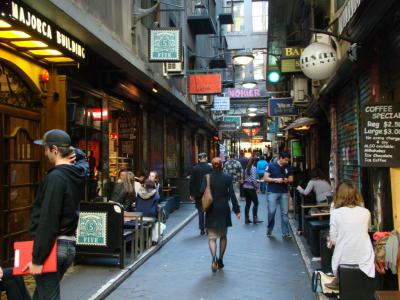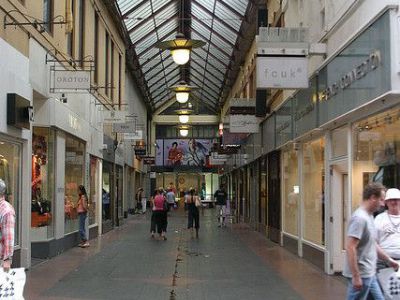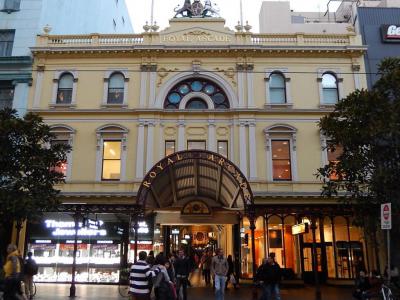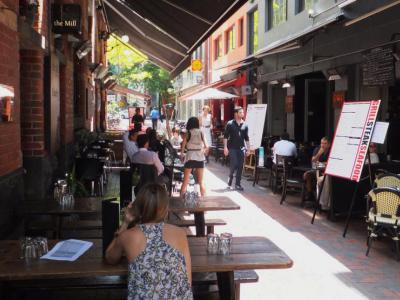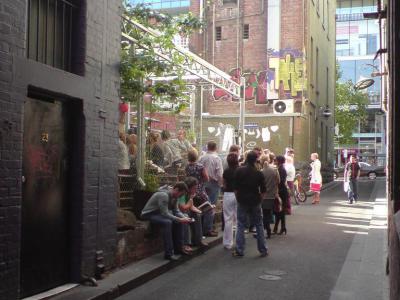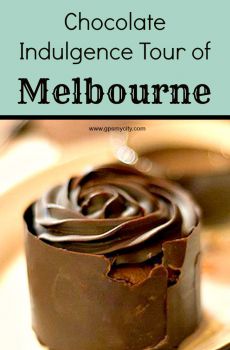
Laneways and Arcades Walking Tour (Self Guided), Melbourne
With over 40 laneways and arcades found in Melbourne, one can easily traverse a good part of the city's Central Business District through them, without even setting foot on a street. Many of these laneways date back to the Victorian era and are packed to the brim with all sorts of retail establishments and eateries – each with its own distinctive character and charm.
One of the most iconic laneways is Degraves Street, an inviting pedestrian thoroughfare brimming with quaint cafes, boutique shops, and vibrant street art. Nearby, Centre Place boasts a similar atmosphere with lively outdoor dining and eclectic storefronts. Both these locations epitomize Melbourne's cafe culture and are perfect spots for a leisurely coffee break or a quick bite.
Venturing further, the Block Arcade is a testament to Melbourne's architectural heritage, featuring stunning Victorian-era design and high-end boutiques. Similarly, Cathedral Arcade, with its striking glass canopy and boutique stores, offers a sense of grandeur and elegance in the heart of the city.
Meanwhile, Howey Place exudes a more intimate charm, housing boutique fashion outlets tucked away from the bustling streets. Royal Arcade, on the other hand, showcases historical opulence with its iconic clock and unique shopping experiences.
For those seeking a culinary adventure, Hardware Lane and Tattersalls Lane are foodie paradises, teeming with diverse eateries, from classic Italian trattorias to trendy fusion restaurants. These laneways are a food lover's dream, offering a chance to savor global cuisines in an alfresco setting.
In essence, Melbourne's laneways and arcades encapsulate the city's vibrant spirit, combining history, culture, and gastronomy in a uniquely charming way. Both residents and visitors enjoy mingling here for an essential Melbourne experience. So, why not follow suit and take a leisurely stroll through these cute locations, discovering the hidden treasures and flavors that make Melbourne truly exceptional? Your quest is going to be well worth it!
One of the most iconic laneways is Degraves Street, an inviting pedestrian thoroughfare brimming with quaint cafes, boutique shops, and vibrant street art. Nearby, Centre Place boasts a similar atmosphere with lively outdoor dining and eclectic storefronts. Both these locations epitomize Melbourne's cafe culture and are perfect spots for a leisurely coffee break or a quick bite.
Venturing further, the Block Arcade is a testament to Melbourne's architectural heritage, featuring stunning Victorian-era design and high-end boutiques. Similarly, Cathedral Arcade, with its striking glass canopy and boutique stores, offers a sense of grandeur and elegance in the heart of the city.
Meanwhile, Howey Place exudes a more intimate charm, housing boutique fashion outlets tucked away from the bustling streets. Royal Arcade, on the other hand, showcases historical opulence with its iconic clock and unique shopping experiences.
For those seeking a culinary adventure, Hardware Lane and Tattersalls Lane are foodie paradises, teeming with diverse eateries, from classic Italian trattorias to trendy fusion restaurants. These laneways are a food lover's dream, offering a chance to savor global cuisines in an alfresco setting.
In essence, Melbourne's laneways and arcades encapsulate the city's vibrant spirit, combining history, culture, and gastronomy in a uniquely charming way. Both residents and visitors enjoy mingling here for an essential Melbourne experience. So, why not follow suit and take a leisurely stroll through these cute locations, discovering the hidden treasures and flavors that make Melbourne truly exceptional? Your quest is going to be well worth it!
How it works: Download the app "GPSmyCity: Walks in 1K+ Cities" from Apple App Store or Google Play Store to your mobile phone or tablet. The app turns your mobile device into a personal tour guide and its built-in GPS navigation functions guide you from one tour stop to next. The app works offline, so no data plan is needed when traveling abroad.
Laneways and Arcades Walking Tour Map
Guide Name: Laneways and Arcades Walking Tour
Guide Location: Australia » Melbourne (See other walking tours in Melbourne)
Guide Type: Self-guided Walking Tour (Sightseeing)
# of Attractions: 8
Tour Duration: 1 Hour(s)
Travel Distance: 1.6 Km or 1 Miles
Author: vickyc
Sight(s) Featured in This Guide:
Guide Location: Australia » Melbourne (See other walking tours in Melbourne)
Guide Type: Self-guided Walking Tour (Sightseeing)
# of Attractions: 8
Tour Duration: 1 Hour(s)
Travel Distance: 1.6 Km or 1 Miles
Author: vickyc
Sight(s) Featured in This Guide:
- Cathedral Arcade
- Degraves Street
- Centre Place
- Block Arcade
- Howey Place
- Royal Arcade
- Hardware Lane
- Tattersalls Lane
1) Cathedral Arcade
On the corner of Flinders Lane and Swanston Street, you'll find the historic Cathedral Arcade on the bottom floor of the Nicholas Building. There are a few shops and cafes, but the real attraction is the beautiful building itself and its architectural details. The leadlight archway and central domes were built in 1925. It's listed on the Victorian Heritage Register for its amazing art deco architecture and details.
The Nicholas Building was designed by Harry Norris and is one of the landmark buildings in Melbourne. It was finished in 1926 at the height of the art deco movement. The style of the building is often referred to as Commercial Palazzo or Chicago School. There are many classic elements in the terracotta facade, including giant ionic and Doric columns. Most of the building's tenants have traditionally been in creative industries, like fashion designers, commercial artists, and architects. You can access the building from inside the Cathedral Arcade. If you go on an Open Studio day, you will get a behind-the-scenes look at the artist's studios in the building.
The Nicholas Building was designed by Harry Norris and is one of the landmark buildings in Melbourne. It was finished in 1926 at the height of the art deco movement. The style of the building is often referred to as Commercial Palazzo or Chicago School. There are many classic elements in the terracotta facade, including giant ionic and Doric columns. Most of the building's tenants have traditionally been in creative industries, like fashion designers, commercial artists, and architects. You can access the building from inside the Cathedral Arcade. If you go on an Open Studio day, you will get a behind-the-scenes look at the artist's studios in the building.
2) Degraves Street
Running between Flinders Street and Flinders Lane, this spot feels a little like Paris. This short, narrow laneway is made from cobbled stone and is pedestrian-only. You can find many cafes for coffee or wine or gift shops with goods from local artists here. If you're looking for a spot to dine alfresco on a beautiful summer afternoon, Degraves is the place to go. Degraves is often mistaken with Centre Place, another laneway nearby.
Many taller buildings on Degraves have been redeveloped into loft-style apartments, which gives the area a vibrant feel. You're sure to see street performers, street art, and graffiti; all are common here, and all add to the atmosphere.
The spot is named for Charles and William Degraves, pioneers and merchants from Hobart. They set up a flour mill in the area in 1849, and William was involved in local politics for many years.
Degraves connects the bustling Flinders Street Station to the shopping districts north of it, so it's quite busy. Campbell Arcade, which is sometimes called the Degraves Underpass, runs under Flinders Street to make the passage easier. There you'll find the Platform Artists Group who frequently displays artwork there.
Many taller buildings on Degraves have been redeveloped into loft-style apartments, which gives the area a vibrant feel. You're sure to see street performers, street art, and graffiti; all are common here, and all add to the atmosphere.
The spot is named for Charles and William Degraves, pioneers and merchants from Hobart. They set up a flour mill in the area in 1849, and William was involved in local politics for many years.
Degraves connects the bustling Flinders Street Station to the shopping districts north of it, so it's quite busy. Campbell Arcade, which is sometimes called the Degraves Underpass, runs under Flinders Street to make the passage easier. There you'll find the Platform Artists Group who frequently displays artwork there.
3) Centre Place
Are you looking for great food, shopping, and maybe some street art? Centre Place is the spot for you. It's a cramped alleyway that will remind you of Harry Potter's annual trips to Diagon Alley. The blue cobblestone street is lined with boutiques and coffee shops. It's famous for its coffee shops and bars, as well as for its street art and graffiti.
Centre Place is located on the pedestrian thoroughfare that runs from Flinders Street Station to the Collins Street shopping district. Along the route, walkers will pass through the Campbell Arcade, Degraves Street, Centre Place, and the Centreway Arcade.
Centre Place was revitalized in the 1980s to attract more restaurants and businesses. Today it's a popular spot right in the middle of the Melbourne Central Business District (CBD).
Centre Place is located on the pedestrian thoroughfare that runs from Flinders Street Station to the Collins Street shopping district. Along the route, walkers will pass through the Campbell Arcade, Degraves Street, Centre Place, and the Centreway Arcade.
Centre Place was revitalized in the 1980s to attract more restaurants and businesses. Today it's a popular spot right in the middle of the Melbourne Central Business District (CBD).
4) Block Arcade (must see)
Block Arcade is, without a doubt, the swankiest and most beautiful stretch of Melbourne. It was opened in 1892 and features an over-the-top French Renaissance architecture that makes the spot memorable. It's full of tall arches, cornices, and lots of decorative tiles. The arcade is full of boutiques and tea rooms and was once the prime shopping district off of Collins Street.
The arcade is L-shaped, with a large domed rotunda on the corner. Entrances are located on Elizabeth Street and Collins Street. The Collins Street entrance is opposite the even older Royal Arcade.
The name comes from the fashionable practice of "doing the block." In the late 1800s, the city's elite would dress in their best and stroll Collins Street and the arcades. It was the spot in Melbourne to "see and be seen."
Why You Should Visit:
The Block Arcade is a popular tourist attraction since it boasts the city's finest Victorian architecture. Walking the arcade is a trip back in time. It's the perfect place to stroll, window shop, and maybe have a bite to eat. The arcade's entrances are six-story tall facades that are some of the best examples of the Mannerist style of Victorian architecture in the city. The arcade is listed on the Victorian Heritage Register.
Tips:
If you want to live the Victorian way, you must take tea at the Hopetoun Tea Rooms. First opened in 1894, they were completely redecorated in 1976 in Victorian style. Still to this day, the rooms give you the feeling that they are intended for high society. This isn't your ordinary cup of tea!
You may also want to check out the Royal Arcade, right across from the Collins Street entrance of the Block Arcade. Also, Block Court is adjacent. It has an elaborate Art Deco interior. It's no longer an arcade with shopfronts but is worth checking out regardless.
The arcade is L-shaped, with a large domed rotunda on the corner. Entrances are located on Elizabeth Street and Collins Street. The Collins Street entrance is opposite the even older Royal Arcade.
The name comes from the fashionable practice of "doing the block." In the late 1800s, the city's elite would dress in their best and stroll Collins Street and the arcades. It was the spot in Melbourne to "see and be seen."
Why You Should Visit:
The Block Arcade is a popular tourist attraction since it boasts the city's finest Victorian architecture. Walking the arcade is a trip back in time. It's the perfect place to stroll, window shop, and maybe have a bite to eat. The arcade's entrances are six-story tall facades that are some of the best examples of the Mannerist style of Victorian architecture in the city. The arcade is listed on the Victorian Heritage Register.
Tips:
If you want to live the Victorian way, you must take tea at the Hopetoun Tea Rooms. First opened in 1894, they were completely redecorated in 1976 in Victorian style. Still to this day, the rooms give you the feeling that they are intended for high society. This isn't your ordinary cup of tea!
You may also want to check out the Royal Arcade, right across from the Collins Street entrance of the Block Arcade. Also, Block Court is adjacent. It has an elaborate Art Deco interior. It's no longer an arcade with shopfronts but is worth checking out regardless.
5) Howey Place
You might see the Howey Place arcade referred to as Cole's Place in some older guides. It starts on Little Collins Street and is a narrow and short laneway between Swanston and Elizabeth Streets. From the back, it connects to the Capitol Arcade on Swanston Street.
Edward William Cole created the arcade in 1896 when he covered this little street with a glass canopy to attract tenants. Some of the original shops included Cole's bookstore, a print shop, and a toy store.
Henry Howey, for whom the street is currently named, bought this parcel of land in 1837 for a whopping 128 Pounds Sterling. The Howey House, a 1930s art deco building, sat here but was demolished in the 1980s to build the Sportsgirl Centre.
Edward William Cole created the arcade in 1896 when he covered this little street with a glass canopy to attract tenants. Some of the original shops included Cole's bookstore, a print shop, and a toy store.
Henry Howey, for whom the street is currently named, bought this parcel of land in 1837 for a whopping 128 Pounds Sterling. The Howey House, a 1930s art deco building, sat here but was demolished in the 1980s to build the Sportsgirl Centre.
6) Royal Arcade
The Royal Arcade is glamorous and memorable, and in many ways like the Block Arcade. It's the oldest arcade in Melbourne, built in 1870, and is on the Victorian Heritage Register. You can enter the arcade from either Bourke, Elizabeth, or Little Collins Streets. The arcade has been a city landmark since its creation. But over the years, shops had altered the appearance, and numerous architectural features were lost. In the early 2000s, a major refurbishment was completed that once again unified all of the shops to their 1894 appearance and restored many historic features.
There are boutiques, cafes, and vintage goods stores galore. You'll notice the statue of Gog and Magog at the Little Collins Street entrance. The seven-foot-tall statues have framed the giant Gaunt clock since 1892, their arms striking the chime for each hour. They are carved from pine and are like those found in Guildhall, London.
The mythical giants represent the conflict between the ancient Britons and the Trojans. Gog and Magog, sometimes called Corineus and Gogmagog, were captured by Trojans and forced to serve as porters. It is in this capacity that they stand in Guildhall and here at the Royal Arcade. The clock and the statues were added about twenty years after the arcade opened by Thomas Gaunt, a jeweler and clockmaker, who had a shop here.
There are boutiques, cafes, and vintage goods stores galore. You'll notice the statue of Gog and Magog at the Little Collins Street entrance. The seven-foot-tall statues have framed the giant Gaunt clock since 1892, their arms striking the chime for each hour. They are carved from pine and are like those found in Guildhall, London.
The mythical giants represent the conflict between the ancient Britons and the Trojans. Gog and Magog, sometimes called Corineus and Gogmagog, were captured by Trojans and forced to serve as porters. It is in this capacity that they stand in Guildhall and here at the Royal Arcade. The clock and the statues were added about twenty years after the arcade opened by Thomas Gaunt, a jeweler and clockmaker, who had a shop here.
7) Hardware Lane
Hardware Lane is a wide laneway located in the central business district of Melbourne, Australia. It stretches in a north-south direction, running between Bourke Street and Little Lonsdale Street. Notably, it changes its name to Hardware Street when transitioning between Lonsdale and Little Lonsdale Streets.
This laneway has gained fame for its abundance of restaurants and cafes, but it also hosts hairdressers, fast-food establishments, and retail shops. Hardware Lane is a vibrant representation of Melbourne's well-known laneway culture, characterized by a distinct European ambiance and unique red brick pavement. The lane is closed to vehicular traffic from 11 am to 11 pm and occasionally hosts live jazz performances during nighttime hours.
Originally known as Wrights Lane in 1857, it became Hardware Lane in 1927, named after the Hardware House. Previously, it was home to Kirk's Horse Bazaar, established in 1840 by James Bowie Kirk as a horse and livery trading center. It also hosted Melbourne's Tattersall's Club for settling wagers with bookmakers.
Around 1895, when it was still known as Wrights Lane, the area was home to several hotels. The Kirks Bazaar Hotel, dating back to 1866, occupied the eastern corner of Little Bourke Street, while the adjacent corner featured the Governor Arthur Hotel. The Shamrock Hotel was situated at the opposite end of the lane, at the intersection with Lonsdale Street. However, there are no operating hotels on the modern Hardware Lane.
One notable building on Hardware Lane is Dynon's Building at 63-73, consisting of four warehouses designed by William Pitt, renowned for his work on some of the city's finest gothic revival buildings, including the Princess Theatre.
This laneway has gained fame for its abundance of restaurants and cafes, but it also hosts hairdressers, fast-food establishments, and retail shops. Hardware Lane is a vibrant representation of Melbourne's well-known laneway culture, characterized by a distinct European ambiance and unique red brick pavement. The lane is closed to vehicular traffic from 11 am to 11 pm and occasionally hosts live jazz performances during nighttime hours.
Originally known as Wrights Lane in 1857, it became Hardware Lane in 1927, named after the Hardware House. Previously, it was home to Kirk's Horse Bazaar, established in 1840 by James Bowie Kirk as a horse and livery trading center. It also hosted Melbourne's Tattersall's Club for settling wagers with bookmakers.
Around 1895, when it was still known as Wrights Lane, the area was home to several hotels. The Kirks Bazaar Hotel, dating back to 1866, occupied the eastern corner of Little Bourke Street, while the adjacent corner featured the Governor Arthur Hotel. The Shamrock Hotel was situated at the opposite end of the lane, at the intersection with Lonsdale Street. However, there are no operating hotels on the modern Hardware Lane.
One notable building on Hardware Lane is Dynon's Building at 63-73, consisting of four warehouses designed by William Pitt, renowned for his work on some of the city's finest gothic revival buildings, including the Princess Theatre.
8) Tattersalls Lane
Tattersalls Lane is full of unique and crazy finds, and the only way to discover all that's here is to spend a late evening wandering around. The laneway is a transition from the Central Business District (CBD) and Chinatown, so as you might expect, there are many Asian influences here. The lane was named for the Tattersalls Hotel and Club operated here during Melbourne's early days.
Among the many attractions include an all-you-can-eat Indian restaurant and the Shanghai Dumpling House. Xialong Kan serves hot pots of all different kinds. Section 8 is a local institution—it's a shipping container turned grunge hangout. This "permanent pop-up" bar is complete with party lights and wood pallets for seating. Upstairs you'll find Ferdydurke, a fun bar with amazing cocktails and a fantastic atmosphere. Besides the food and bars, Tattersalls is one of the city's best street art destinations. The walls are covered with art of all types.
Among the many attractions include an all-you-can-eat Indian restaurant and the Shanghai Dumpling House. Xialong Kan serves hot pots of all different kinds. Section 8 is a local institution—it's a shipping container turned grunge hangout. This "permanent pop-up" bar is complete with party lights and wood pallets for seating. Upstairs you'll find Ferdydurke, a fun bar with amazing cocktails and a fantastic atmosphere. Besides the food and bars, Tattersalls is one of the city's best street art destinations. The walls are covered with art of all types.
Walking Tours in Melbourne, Australia
Create Your Own Walk in Melbourne
Creating your own self-guided walk in Melbourne is easy and fun. Choose the city attractions that you want to see and a walk route map will be created just for you. You can even set your hotel as the start point of the walk.
St. Kilda District Walking Tour
A cosmopolitan seaside suburb of Melbourne overlooking Port Phillip Bay, Saint Kilda District is a charming and culturally rich neighborhood graced with a blend of historical landmarks and contemporary attractions.
One of its prominent sites is the Saint Kilda Town Hall, an imposing municipal building that serves as a hub for various community events and gatherings.
Eildon Mansion, another... view more
Tour Duration: 2 Hour(s)
Travel Distance: 3.5 Km or 2.2 Miles
One of its prominent sites is the Saint Kilda Town Hall, an imposing municipal building that serves as a hub for various community events and gatherings.
Eildon Mansion, another... view more
Tour Duration: 2 Hour(s)
Travel Distance: 3.5 Km or 2.2 Miles
Historical Buildings Walking Tour
Melbourne's architecture is a rich cocktail of styles ranging from those practiced in the early years of European settlement of Australia to the more modern ones. Among the historical buildings particularly noticeable here are those from the Victorian era, forming an essential part of the city's heritage.
The Old Melbourne Gaol once served as a prison, from 1842 to 1929, and is... view more
Tour Duration: 2 Hour(s)
Travel Distance: 4.1 Km or 2.5 Miles
The Old Melbourne Gaol once served as a prison, from 1842 to 1929, and is... view more
Tour Duration: 2 Hour(s)
Travel Distance: 4.1 Km or 2.5 Miles
Melbourne Food Tour
Relatively small compared to the likes of New York City or London, Melbourne is quite big when it comes to food – standing tall among major international culinary destinations. The influence of multiple waves of immigration from Europe and Southeast Asia has rendered this Australian city's gastronomic landscape insanely varied and opulent.
Indeed, the local food scene caters to a wide... view more
Tour Duration: 1 Hour(s)
Travel Distance: 2.2 Km or 1.4 Miles
Indeed, the local food scene caters to a wide... view more
Tour Duration: 1 Hour(s)
Travel Distance: 2.2 Km or 1.4 Miles
Melbourne Introduction Walking Tour
Melbourne is the capital and largest city in the Australian state of Victoria. The metro area consists of 31 different towns spread around the bay of Port Philip. Indigenous Australians have lived here for more than 40,000 years. European settlement began in the 1830s when settlers arrived from Van Diemen's Land (Tasmania). The settlement, incorporated in 1837, was named for the British Prime... view more
Tour Duration: 2 Hour(s)
Travel Distance: 3.5 Km or 2.2 Miles
Tour Duration: 2 Hour(s)
Travel Distance: 3.5 Km or 2.2 Miles
Useful Travel Guides for Planning Your Trip
Chocolate Indulgence Tour of Melbourne
Melbourne has a reputation for cafés and fine restaurants, and lately a chocolate fever has taken over the city. This tour takes you through the alleyways and arcades of the city center whilst stopping at selected chocolate indulgence points. Take your senses on a unique experience through six of...
The Most Popular Cities
/ view all
